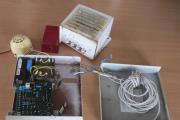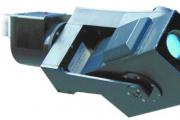Security alarm for home, cottage, garage, greenhouse: how to install a simple alarm system with your own hands. How to make an alarm at home? A simple do-it-yourself security alarm scheme
The article provides a diagram of a simple burglar alarm, a description of the work, resident software (firmware). The device is not difficult to assemble with your own hands. All the information you need for this is in the article.
General description of the device.
The security alarm is assembled on the PIC controller PIC12F629. This is a microcontroller with 8 pins and the price is only 0.5$. Despite its simplicity and low cost, the device provides control of two standard alarm loops. The alarm system can be used to protect large enough objects. The device is controlled by a remote control with two buttons and one LED.
Our company has moved to a new building. From the previous owners there was an old burglar alarm. It was an iron box with red LEDs and a siren above the front door and a broken electronic unit.

I installed a small circuit board in the alarm unit and turned this junk into a modern, reliable burglar alarm. At the moment it is used to protect a two-storey building with a total area of 250 m 2 .
So, the alarm provides:
- Control of two standard security loops with measurement of their resistance and digital filtering of signals.
- Remote control (two buttons and one LED):
- turning on the alarm;
- disabling the alarm through a secret code
- setting a secret code (the code is stored in the internal non-volatile memory of the controller);
- operation mode indication by remote control LED.
- The device generates the time delays necessary for dialing the secret code, closing the doors of the room, etc.
- When the alarm is triggered, the device turns on the sound annunciator (siren).
- The operating mode of the device is also displayed by an external light source.
The block diagram of the security alarm looks like this.

Connected to the main security alarm unit:
- 2 security loops with
- NC - normally closed sensors;
- NR - normally open sensors;
- Rok - terminating resistors.
- External block of the sound notification and mode indication.
- Backup power source.
- Power supply 12 V.
Loops of the security alarm system and connection of sensors.
To control sensors (detectors), the device uses standard security loops. Loop resistance is controlled. If the circuit resistance is greater than the upper or less than the lower threshold, an alarm is generated. Normal is the loop resistance equal to the terminating resistor (2 kOhm). Thus, if an intruder breaks the wires of the loops or closes them, the alarm will go off. In this way, it will not work to disable security sensors.
In this device, the following threshold values of the loop resistance are selected.
Those. loop resistance in the range of 540 ... 5900 ohms is considered normal. If the resistance value goes out of this range, an alarm will be triggered.
Scheme of connecting sensors (detectors) to the security loop.

Both normally closed security sensors (NC) and normally open (NO) can be connected to one loop. The main thing is that in the normal state the circuit has a resistance of 2 kOhm, and when any sensor is triggered, it causes an open or short circuit.
To increase the noise immunity of the system, the device digitally filters the loop signals.

In principle, everything should be clear. Connected to the PIC12F629 microcontroller:
- Two loops through RC chains R1-R6, C1, C2, providing
- formation of power supply of the loop;
- analog signal filtering;
- matching with the input levels of the PIC controller inputs.
To determine the resistance of the loops, a microcontroller comparator is used. An internal reference voltage source is connected to the second input of the comparator. The values of the reference voltage source (RH) for comparison with the upper and lower threshold resistance values are set by software.
- Through the RC chains R7-R10, C3, C4, two remote control buttons and an LED are connected through a current-limiting resistor R11. The device provides digital filtering of button signals to eliminate chatter and improve noise immunity.
It is worth explaining the purpose of the resistor R17. The GP3 input of the microcontroller has an alternative function - a 12 V supply for programming the microcircuit. Therefore, it does not have a protective diode limiting the voltage at the level of the supply voltage. At a voltage of 12 V at this pin, the microcontroller enters the programming mode. Resistor R17 reduces the voltage at the GP3 input.
- Through two transistor switches VT1, VT2, the microcontroller controls the siren and external LED indication. Because these elements can be connected with a long cable, the transistors are protected from line surges by VD4-VD7 diodes. Transistor switches allow switching current up to 2 A.
- A voltage of 5 V to power the PIC controller is generated by the stabilizer D2. Do not ignore the VD8 LED. Its functions include not only power indication, but also the creation of a minimum load for the microcontroller. If the PIC controller consumes current less than 2-3 mA (for example, in reset mode), then the voltage of 12 V through resistors R8, R10 can raise the microcontroller supply voltage above the allowable one.
- The inputs for the 12 V power supply and the backup power supply are separated by diodes VD2, VD3. A Schottky diode is used as a VD2 diode in order to provide priority to the power supply when the voltages are equal to the backup power source.
I assembled the device on a 54 x 45 mm board.

Installed it in the body of the old alarm. Left only the power supply.

The remote control is made in a plastic case with dimensions of 65 x 40 mm.

Software.
The resident software is developed in assembler. The program cyclically resets all variables and registers. The program cannot hang.
You can download firmware for PIC12F629 in HEX format.
Management of the security alarm system from the panel.
The remote control is a small box with two buttons and an LED.

It is better to install it indoors near the front door. With the help of the remote control, the alarm is turned on and off, the secret code is changed.
Modes and control.
When power is first applied, the device enters ALARM OFF mode. The LED is not lit. In this mode, the device is during the working day.
To turn on the alarm (ARMED mode), you must press two buttons at once. The LED will begin to blink rapidly, and after 20 seconds the device will switch to ARMED mode, i.e. will start monitoring the state of the sensors. This is the time it takes to leave the room and close the front door.
If during this period of time (20 seconds) any button is pressed, the device will cancel the armed mode and return to the ALARM DISABLED mode. Often people remember something just before leaving the building.
20 seconds after switching on, the device will switch to the ARMED mode. In this mode, the LEDs of the remote control and the external indication unit blink approximately once per second. In the ARMED mode, the state of the sensors is monitored.
When any security sensor is triggered, the LEDs begin to flash frequently, and the alarm counts down the time after which the siren will sound. This time (30 seconds) is necessary in order to have time to turn off the alarm by typing the secret code on the remote control buttons.
There are 2 buttons on the remote control. Therefore, the code looks like a number from the numbers 1 and 2. For example, the code 121112 means that you need to press the buttons 1, 2, three times 1 and 2 in sequence. The code can have from 1 to 8 digits.
If the code is entered incorrectly or incompletely, you can press two buttons at the same time and repeat the code entry.
If the correct code is entered, the device switches to the ALARM OFF mode.
If within 30 seconds after the sensor was triggered, the correct code was not dialed, then the siren turns on. You can disable it by typing the correct code. Otherwise, the siren will sound for 33 seconds and then the unit will turn off (go into ALARM OFF mode).
It remains to explain how to set the secret code. This can only be done from the ALARM OFF mode.
Both buttons must be held down for 6 seconds. Release when the remote control LED lights up. This will mean that the device has entered the passcode setting mode.
Then wait until the LED goes out (5 sec). The device will enter the ALARM OFF mode, and the new code will be stored in the internal non-volatile memory of the microcontroller.
Because Since the microcontroller of the device is clocked from an internal generator of low accuracy, the specified time parameters may differ by ±10%.
Alarm states.
| Mode | State LED |
Jump condition | Change to mode |
| ALARM DISABLED | Does not glow | Short press of two buttons | Waiting for GUARD (20 sec). |
| Holding two buttons pressed for 6 seconds | Setting the passcode | ||
| Waiting for security You need to get out and close the front door. |
Flashing fast | Time 20 sec | SECURITY |
| Pressing any button (cancel) | ALARM DISABLED | ||
| SECURITY | Flashes once per second | Sensor trips | |
| Time to turn off the alarm code (30 sec) Necessary in order to deactivate the alarm by dialing the code |
Flashing fast | Correct code dialed | ALARM DISABLED |
| Correct code not dialed within 30 seconds | Siren sound (anxiety) |
||
| Siren sound (alarm) | Flashing fast | Correct code dialed | ALARM DISABLED |
| Time 33 sec | ALARM DISABLED | ||
| Setting the passcode | Constantly lit | Code set | ALARM DISABLED |
In practice, work with signaling comes down to actions.
- Leaving the room. Press two buttons at the same time and close the door within 20 seconds.
- Upon entering the room. Within 30 seconds, dial the secret code.
Drawbacks, possible improvements.
The device can be easily modified for its specific conditions. All improvements relate only to the hardware. They do not affect software.
- It is advisable to install two sirens. One in the outdoor indication and warning block, the other in a hard-to-reach place. The current of the transistor key (2 A) allows this to be done.
- It would be necessary to protect the siren wires from short circuit with a transistor current stabilizer. In the presented version of the scheme, an attacker can close the wires of the siren and, when the alarm is triggered, a short circuit of the power source will occur.
- If desired, you can connect powerful and high-voltage sources of light, sound, etc. through electromagnetic relays. The allowable current of the keys allows this, and the keys are protected against surges when switching the relay winding.
- A battery can be used as a backup power by adding a simple charge circuit to the circuit.
Appearance of the installed alarm system.

Now only the front door sensor is connected to the device. I plan, over time, to add security sensors. Two loops are quite enough to guard our two-story building.
By the way, if only one loop is used, then a 2 kΩ resistor must be connected to the second.
There are other software options for the device on the site's forum. There you can discuss, ask questions about this project.
The Russians have always been famous for their ability to do all the housework on their own, without involving specialists. Most men are decently versed in plumbing, electrics, installation work and in the device of the car. Therefore, do-it-yourself burglar alarms, for many, are not a myth, but a reality. Of course, this will require certain skills, knowledge of electrical engineering and the availability of the right tool.
Security alarm for an apartment
Self installation options in your own apartment there are only two effective burglar alarms. The first option involves the purchase of a ready-made kit, which has everything you need for a small home alarm. And if you purchase a wireless system, then you do not need to do anything. Enough to place sensors in the right places and set up the device according to the instructions. This option has its weaknesses. First of all, the price, which cannot be called too low, then, for some reason, the proposed device and security sensors may not be satisfied. The proposed equipment may not be sufficient to organize a security alarm in a particular apartment.
Therefore, many prefer the second option, when all components are purchased independently and installation work is also carried out without the help of specialists.
Security alarm kit
Every burglar alarm, no matter is it simple or complex, should effectively protect all premises of the apartment and give a signal in case of any violations of the protected area. The main elements of the security system are sensors, each of which responds to a specific action or event. According to their purpose, the number of sensors is limited.
There are only a few varieties:
- Magnetic sensors
- Motion detectors
- Sound sensors
- Vibration sensors
A pair of "magnet-reed switches" is installed on doors and window sashes. When everything is closed, the magnetic field keeps the contact plates closed.
It is worth slightly opening the door or window, as the magnet will move away from the contact pair, and it will open. This is the most inexpensive and fairly reliable sensor included in all security alarm systems.
Sensors
 A reliable burglar alarm scheme also uses motion detectors that are triggered as soon as an object enters the detection zone of the sensor. These devices come in many types, but PIR motion detectors are used for private burglar alarm systems. They are cheaper than radio wave microwave sensors and more reliable than ultrasonic ones. Each sensor has a clearly defined detection zone.
A reliable burglar alarm scheme also uses motion detectors that are triggered as soon as an object enters the detection zone of the sensor. These devices come in many types, but PIR motion detectors are used for private burglar alarm systems. They are cheaper than radio wave microwave sensors and more reliable than ultrasonic ones. Each sensor has a clearly defined detection zone.
Most infrared motion sensors have a zone length of 10-12 meters, and a capture angle of 90 0 .
Typically, such devices are installed according to the principle - one room - one sensor, but there are exceptions. If there are several windows in the room on the same wall, then an infrared “curtain” detector is installed, which forms a narrow vertical, but extended horizontal zone that blocks all windows along the wall.
Sound (acoustic) sensors react to the sound of breaking glass. They form an additional security line. As a result of installing three types of sensors, the room will be completely blocked and penetration into it through the window and through the door is almost impossible. Vibration sensors react to attempts to dig or destroy (break) the wall and are rarely used in domestic security alarms.
Sirens
In addition to sensors, any burglar alarm must have a warning device. Most often, a low-current siren is used, combined in one housing with an LED indicator. Such a device, in case of violation, gives a sharp signal with a sound pressure of 90 to 115 dB, which will simply frighten off the intruder. In addition, the sound of the siren along with the red flashes of the LED indicator will attract the attention of neighbors.
Power alarm
 For reliable and uninterrupted operation of the security alarm, you should take care of the correct power supply. Power outages require the use of power supplies with built-in batteries in security systems. Such devices allow the alarm to function normally for several hours.
For reliable and uninterrupted operation of the security alarm, you should take care of the correct power supply. Power outages require the use of power supplies with built-in batteries in security systems. Such devices allow the alarm to function normally for several hours.
To perform installation work, you will need wire, cable duct and fasteners. The wiring of the security alarm is carried out with a wire KSPV 4 X 0.5. Two of the four wires are used to supply power to the sensors, and two more form a signal loop. To connect the network, a SHVVP wire or similar is used. Installation of sensors and laying of the cable channel is carried out using dowels and self-tapping screws.
PKP - the heart of the burglar alarm
The basis of the burglar alarm is control panel - PKP. For a simple security system, it is enough to use a device with one or two loops. Such a device is inexpensive, but has a well-developed functionality and is perfect for a small apartment alarm.
Common devices with one loop:
- Quartz
- Astra 712/1
- VERS-PK 1
The cost of devices does not exceed 1900 rubles. Each device has a place to install a battery in the case. Arming and disarming is carried out with the help of electronic keys "Touch Memory", which are included in the delivery.
Video how to make an alarm from the phone:
Self-installation of a security alarm
Before purchasing everything you need for a security alarm, it is recommended that you complete the entire installation plan on paper. This will help avoid errors in sensor placement and will help determine the exact number of elements required.
To make a simple burglar alarm yourself, you also need to have the following tool:
- Perforator
- Hammer
- pliers
- wire cutters
- Screwdriver Set
- Tester
Choose a place
First you need to choose a place to install the main unit (PKN). It is usually installed on the wall of the hallway, next to the front door. It is desirable that an electrical panel or junction box be located nearby. In standby mode, the device must be constantly, so the power switch is usually not set. Then security sensors are installed, depending on the number of rooms, and a loop is laid. If the apartment is located above the second floor, it is not advisable to use glass break sensors. All sensors are included in one loop.
The performance of magnetic contact sensors, before being connected to the line, is easy to check with a tester. When the door is closed, the circuit is closed, and opening it by 1-2 cm, you can see how the contacts open.
Installing sensors
Infrared motion detectors are installed at a height of 210-220 cm in the corner formed by the walls. The specific installation location is selected according to the size and configuration of the room. Such sensors are equipped with a swivel bracket, which makes it easier to choose the optimal angle horizontally and vertically.
If the room is small, then the sensor must be oriented so that the window enters the trigger zone, which is indicated in the passport, and if it works out, then the door. There is a red LED on the body of the motion sensor, the glow of which shows the state of the sensor. In standby mode, the diode is constantly on, and when the protected zone is violated, it flashes.
We mount
Installation of a security alarm is carried out with a four-wire KSPV wire, as this allows the design of an apartment or house. It can be laid in a cable duct, run under the baseboard and door jambs. After completing the installation and checking the functionality, you can choose a place to install the signaling device. A triggered siren will force the offender to abandon their intentions, as well as inform the neighbors that something has happened in the apartment or house. The security alarm is controlled by electronic keys, the reader of which is installed next to the device.
Currently, ready-made burglar alarm kits with. Such innovative devices, in case of violation of the protected space, can not only notify the owners of unauthorized entry, but also call a quick response service. Of course, the cost of such devices is somewhat higher than that of conventional alarms, but this is justified by their capabilities.
Video with a non-standard solution for creating an alarm:
Burglar alarm simulators
Do-it-yourself home security alarm system does not have to include expensive control devices and sensors. One of the most or at home would be to install a standard motion sensor that is used to turn on the lights.
The cost of sensors starts from 300 rubles.
Sensors of this type have a large detection area and can switch loads up to 2.0 kW, which allows turning on a powerful siren and lighting in case of violation of the protected area. Such security systems are often installed in garages. This is convenient because, unlike complex devices that can be operated under certain conditions, outdoor motion sensors are operable over a wide temperature range.
In the market of security systems, you can already buy ready-made imitators (models) burglar alarms, which can be self-powered. The simplest ones are a regular red LED that operates in a pulsed mode. In conclusion, we can say that the range of security devices is currently very large, and everyone can choose the best option for themselves.
The use of stand-alone burglar alarms is common. There are many modifications of the wireless system, the configuration of which depends on the conditions of use, the structural features of the area, and the requirements of the owner. The price range is different, the price-quality ratio is acceptable. At the same time, a home-made GSM alarm based on improvised devices is also of interest, especially among those who are familiar with the basics of radio electronics.
GSM alarm: buy or do it yourself?
The answer to the question depends on the requirements, the request for the security installation. The variety of functionality and capabilities of wireless systems is wide. Additional equipment is provided by the design feature of this equipment. If desired, needs, it is possible to organize an autonomous scheme that is optimally suited to this object. First of all, this concerns the protection of private houses, country cottages, city apartments, car garages, etc.
But there are cases when extensive functionality is not needed, it only complicates the use of the device. Here it is recommended to purchase systems simpler, with the necessary set of features. It is not recommended to use the cheapest ones due to poor efficiency and low reliability.
If you have the desire, as well as knowledge from the field of radio electronics, radio engineering, it is possible to organize a GSM alarm system yourself. Complete set - the most basic tools, simple devices (for example, an old mobile phone, Arduino platform, GSM module, battery, etc.).
For the independent organization of a security alarm, it is better to take on a specialist who will do the assembly with high quality, with knowledge of many nuances. This model is suitable for installation inside a garage, a car, a small storage facility. It is recommended to entrust the protection of serious objects (residential buildings, apartments, office premises, shops) to industrial models with remote control, a branched circuit of connected sensors of various directions.
Homemade GSM alarm system from a mobile phone
Often, an independent alarm system is built on the basis of a mobile phone. Necessary set of tools, devices:
- Push-button phone with speed dialing (mandatory).
- If you want to listen - headphones with a microphone from a mobile device.
- Soldering iron, related materials.
- Wiring.
- Reed switch, magnet.
- Battery up to 12V (with external power supply of the mobile).
Sequencing:
- Open the telephone set menu, select “one-button” call settings, fix the mobile number (or group of numbers) to which the DTMF alarm will be sent to a certain button (buttons).
- Dismantle the phone to the board with a glued film.
- With a sharp knife, make cuts under the number that was previously determined in the menu settings for an emergency call. Raise the film, under it there is a metal membrane, which will subsequently close the contacts (grounding, "patch").
- Solder the wires to ground, "patch". To avoid false triggering, it is recommended to use the wires of one loop.
- Seal the membrane to prevent shorting.
- Install the reed switch on the device, the magnet on the door. To prevent a quick opening of the circuit when the door is closed, it is necessary to provide a mechanism that shifts the magnet to the side.
Options for connecting the resulting device to the alarm:
- By means of a relay (normally open contacts).
- Using a biopolar transistor.
- Optocoupler. The most optimal option, creating a galvanic decoupled circuit.
This video describes the scheme in more detail.
How to do? Variant on the Arduino platform
This scheme includes:
- Arduino platform
- GSM modem (SIM900A, SIM800L)
- Power supply, battery.
The system works simply. A connected touch sensor (motion, infrared, etc.) upon detection of intrusion indicators, sends a signal to the system, putting it into standby mode. Alarm notification (predefined sms message) is sent to the set mobile number.
A detailed connection diagram is contained in the video
System Power Methods
- From a mobile phone battery. A simple option in which the lithium battery will always be 100% charged. Over time, this will lead to its failure.
- External power supply (battery up to 12 V). It is connected to the power terminals of the phone together with its battery. In this case, the charge will be kept at the level of 70%. When the main source of electricity is turned off, the cellular battery will power the security device.
- Without mobile battery (when the device is connected to the alarm with its own power supply).
Advantages. Flaws
pros homemade security system:
- The minimum cost of initial components in comparison with industrial options.
- Autonomous operation (only periodic recharging of the phone).
- Prompt response.
- Possibility to connect several subscriber numbers.
- Options for connecting touch sensors.
- Wireless installation.
Minuses:
- The system is easily blocked when detected. Hidden installation required.
- Local actuation.
- Suppression, signal change.
The use of a do-it-yourself GSM system is justified when it is necessary to install a security device with minimal means, and the significance of the object is not high. For a house, apartment, office, it is best to use industrial security modifications that are more reliable, efficient, and functionally diverse.
Friends! More interesting stuff:
 Scope of application of GSM security alarm systems
Scope of application of GSM security alarm systems
 GSM Burglar Alarm: A Brief Overview
GSM Burglar Alarm: A Brief Overview
 Security gsm alarm system for giving
Security gsm alarm system for giving
This article provides diagrams of the simplest electronic alarms, which can be done by anyone who is at least minimally familiar with electronics or simply knows how to hold a soldering iron in his hand. Such alarms come in handy in many cases. They can be put on the windows if there is a small child in the house who can open them. On the doors of an apartment or garage of a guarded parking lot. And when triggered, the watchman will call the police. You can put such an alarm in the apartment if you are friends with your neighbors. Even if you go camping, it’s not a sin to spread a security train around the camp at night in case of wild animals or strangers.
First scheme electronic signaling is simple to the extreme, there is nowhere easier. This is just one transistor, a resistor and an executive relay. If an audible alarm is expected, then instead of a relay, an audible siren or howler is turned on.
Principle of operation: A security loop is a thin wire, or a closed contact. When the wire is intact (or the contact is closed), the base of the transistor is grounded and the transistor is closed. No current flows between collector and emitter.
If you break the security wire, or open the contact, the base will be connected to the power source through the resistor R1, the transistor will open and the relay (or siren) will work. You can turn it off only either by turning off the power, or by restoring the security loop.
Such an alarm can be used to protect your belongings, for example. A reed switch is used as a security contact, the alarm is hidden in the side pocket of a bag or backpack, and a magnet is placed nearby. If the magnet is removed from the alarm itself (move the thing), the siren will squeal in all voices.
Second scheme with more advanced user features

As in the first case, a security loop, a normally closed (in armed mode) contact or a reed switch closed by a magnetic field serves as a sensor. If the loop is violated, an alarm is triggered and its operation continues until the power is turned off. Restoring the loop does not turn off the alarm, it will still continue to work for some time. The alarm has a button for temporary blocking, which is necessary for the owner to leave the protected area. The alarm also has a response delay, which is necessary for the owner to turn it off when he enters the protected area.
Let's analyze how the circuit works. Before arming the alarm, it is necessary to turn off (open) switch S1. It must be installed in a secret place near the entrance. You can use, for example, a hidden reed switch, which closes - opens by rearranging some object with a magnet built into it, etc. This switch blocks the operation of the system and it stops responding to a broken loop. When leaving, the switch S1 opens and the capacitor C2 begins to charge through the resistor R2. Until the capacitor is charged to a certain value, the system is "blind". And you have time to leave the object, restoring the security loop or closing the contacts. By selecting the values of resistor R2 and capacitor C2, achieve an acceptable output delay for yourself.
If the security loop is broken, then the capacitor C1 will start charging through the resistor R1. This pair creates a slight delay in the alarm, and the owner has time to neutralize it by turning on switch S1. It is necessary to choose the values of the resistor and capacitor for a comfortable response delay time.
If the loop is broken by an intruder who does not know how to turn off the alarm, then some time after the loop is broken, the alarm will work (both inputs of the D1.1 element will have a logical "1", respectively, at the output "0". After passing through the inverter D1 .2 it will again become "1" and open the transistor VT1. The transistor will discharge the capacitor C3 and open the transistor VT2 through the inverter, which will cause the executive relay to work or turn on the siren.
Even if the attacker quickly restores the loop, the siren will continue to work, since the capacitor C3 will charge through the resistor R3 for a sufficient time. It is the ratings of this pair that determine the operating time of the alarm after the loop is restored. If the loop is not restored, the alarm will work constantly.
Chip - K561LA7, transistors - any n-p-n (KT315, KT815, etc.) Power supply - any with a voltage of +5 - +15 Volts. The executive relay or siren can be connected to a more powerful power source than the circuit itself. In standby mode, the circuit consumes practically no current (at the level of self-discharge of batteries).
This is the simplest type of dacha alarm. It consists of the body of the sensor itself and an external permanent magnet. The housing of the security device must be mounted on the door or window opening, the magnet must be fixed on the window or door. When the window is closed, both housings are nearby, and the alarm contact in the reed switch is closed, since it is affected by a magnetic field. When a window is opened by a thief, the magnet moves away from the sensor housing and an alarm signal is sent to the siren circuit.

GSM alarm system is intended for remote monitoring of protected objects and notification of the owner of the cottage through GSM communication channels (mobile phone). GSM video surveillance of summer cottages creates a completely new level of security and control - through MMS, GPRS or 3G cameras. Now the owner of the garden plot will receive more information in the event of a protection operation. Also, the owner of the dacha has irrefutable evidence of the incident in the form of pictures from a connected camera or recordings. In this collection, we will consider several do-it-yourself gsm signaling options.
If a wood-burning stove or other gas equipment is installed in the country house, then it is advisable to take care of installing a gas detection sensor. By the way, an alarm based on it is easy to do with your own hands.

Carbon monoxide or carbon monoxide, CO (not to be confused with CO2) is one of the most dangerous combustion products. It is part of almost any smoke and is released during smoldering of absolutely all organic or carbon-containing compounds. This is a deadly gas and an alarm about its presence will be relevant both in the country house and in a private house. Carbon monoxide is completely odorless, which nullifies its detection by the senses. A person can understand the presence of carbon monoxide in the inhaled air only by the first symptoms of poisoning, and in many cases it is already too late.
With the help of today's popular Arduino board, you can create a budget wireless alarm system for your home, apartment or cottage. At the same time, this alarm is very easy to repeat and is recommended for both beginner radio amateurs and already more advanced arduino people.
The principle of operation of laser signaling is as follows: when an object enters the beam coverage area, the laser stops illuminating the photodetector. The resistance of the latter increases sharply and the relay turns off. The relay contacts also turn off the laser. This is a variant of the simplest scheme. When a laser beam hits a photoresistor, its resistance tends to zero, and when the laser is turned off, its resistance increases dramatically and greatly. The photoresistor must be placed in a closed case.
As observations of the operational reports of the Ministry of Internal Affairs show, the largest number of thefts from closed premises are committed through opening the door. Even the presence of a safe door with English locks will not provide full protection. Therefore, to reduce the risk of theft, I recommend installing a homemade alarm on the door, which will play the role of active protection. Yes, and experienced thieves, seeing a homemade product, cannot know what it is capable of and will choose another object for attack. A country door alarm is an excellent option for additional protection of your cottage from unwanted visitors.
There is no smoke without fire, as the old Russian proverb says. It is on this principle that fire detectors work to detect fire by smoke in a country house. The sensor has a chamber with a diode and a photodetector. When smoke enters it, the radiation strength of the diode changes, which serves as a signal for the fire sensor to operate. The use of a smoke converter, in comparison with a temperature sensor, allows you to find out about a fire much earlier and, accordingly, allows the owner of the cottage to take measures to extinguish or save his property. Protecting a summer house from a fire is an actual option for any owner.
With the onset of spring, the owner of a summer cottage wants to quickly find out about a possible flooding of the basement. Also, when water supplying a country house, you want to be sure that there will be no leaks into the underground, because this will significantly reduce the life of the floor lags.

Consider a diagram of a simple home-made country alarm system that can be used in various rooms or in containers. For example, these sinal sensors are very often used to detect possible flooding of the basement of a summer house or the cellar of a garage with melt water or in the kitchen under the sink, etc.
www.texnic.ru
Do-it-yourself alarm - for giving, alarm diagram, diagram description
Dear visitors!!!
In the summer, many of us prefer to be at our dacha, secluded from the bustle of the city, spending our time working on growing vegetables, fruits and berries, and someone is directly passionate about the work of beekeeping, that is, breeding bees and obtaining the final productive result, - the collection, sale of honey and the technology of breeding bee colonies. But this topic has nothing to do with various hobbies, running your own household, but as you understand, we will talk here about a security alarm, which is necessary both for:
- suburban area;
- garden plot in a private house,
And for the protection of their beekeeping.
Circuit Description
Here is a simple electronic circuit, parts of which are freely available from specialized stores. The scheme, as you can see, consists of:
- two transistors;
- resistor;
- batteries;
- push button switch;
- capacitor
and dynamics.
To assemble this circuit, you must have available:
- silicon transistor type n-p-n (T1) MP 111;
- silicon transistor type p-n-p (T2) MP 40;
- MLT resistor from the BC series;
- paper capacitor 0.1 microfarad;
- speaker 1 GD-39
and a push-button switch (from a table lamp).

fence perimeter
Along the perimeter of the protected area (fence), a thin copper wire is stretched, the ends of which are connected, as shown in the diagram, to the input terminals (in). When the copper wire breaks, the speaker emits a sound signal. This signal can be changed by selecting the capacitance of the capacitor.
Elements for the electronic circuit
All the necessary elements that will be required during assembly, installation of elements on the circuit board are shown in the photographs:
silicon transistors
capacitor paper resistor MLT

battery 4.5 Volt push button switch
speaker 1GD-39 (from the radio)
To make a ready-made so-called motherboard on your own, the circuit itself (tracks) is directly applied to the printed circuit board blank - with nail polish. Everything else is etched with “ferric chloride” and your circuit is ready for mounting electronic elements, the necessary holes on the board are made with an awl.
That's all for now. Follow the rubric.
zapiski-elektrika.ru
How to make an alarm with your own hands at home?

In the modern world, it is almost impossible to do without security equipment - this is especially true for protecting your real estate from robbers who are constantly improving ways to enter a house, apartment, cottage or garage. For such cases, electronic security systems in the form of alarms are effective. These security barriers minimize the likelihood of theft and allow the property owner to respond in time to a dangerous situation. Today, many companies offer a wide range of multifunctional alarm systems, as well as their installation and maintenance. Depending on the complexity of the security kit used, its cost will also depend, which can sometimes be quite large. If the owner of the house does not have the opportunity to purchase and install an expensive security kit, he thinks about how to make an alarm system with his own hands. It turns out that this is not such a complicated process - it is important to understand at least a little about electronics and electrical work, and it will not be difficult to make an alarm.

Do-it-yourself alarm option for the door
Advantages of a homemade alarm
Despite the fact that a homemade alarm system is created at home, it has a number of advantages that allow it to compete with factory security systems.
Firstly, the simplest do-it-yourself home alarm system can be implemented even from improvised means that are available in the household. Almost every house has an unused mobile phone, elements of executive devices for various household equipment, etc. If something is missing, then it can be bought for a penny on any radio market. The financial costs of a security system created at home are minimal.
Secondly, a home-made alarm can be easily changed structurally and upgraded to the changed operating conditions at the facility at any time. Not every factory security system will be able to do this.
Flaws
No matter how good your burglar alarm design would be, it is not without flaws. The main ones include the following:
- lack of built-in protection systems against various devices that are used by intruders to turn off alarms;
- the impossibility of connecting such devices to the security systems of security companies;
- it is difficult to independently implement complex security configurations, which include a wide range of security and functional sensors, actuators;
- home-made simple alarm does not support the ability to conduct audio and video monitoring from a protected facility;
- without basic knowledge of electronics, it will not work to make your own security system.
What types of alarms can be done with your own hands?
At home, you can independently implement several options for security systems that will solve specific problems of protecting real estate.
- Motion sensor alarm
A simple do-it-yourself alarm system for an apartment can be created on the basis of a conventional motion sensor, which is equipped with lighting systems installed in entrances and landings. If you connect a siren to such a sensor instead of a lighting element, you get an elementary security system that will warn you with a sound signal that someone is in the protected area.

Alarm based on motion sensor with battery
- Alarm based on ready-made kits
For those who do not want to “puzzle” how to make a homemade alarm and which devices to use for this device, you can use ready-made kits that are sold on every radio market. It will only be necessary to draw up a diagram of protected areas and purchase the appropriate sensors and actuators for this. In the future, you will have to install the purchased elements and configure them to perform the appropriate security functions.
- Alarm based on magnetic contact sensors
For those who are thinking about how to make an alarm at home, which will respond to the opening of doors and windows, the option on magnetic contact sensors will be the best solution. A distinctive feature of such sensors is that they include two elements - the actual base of the sensor and the magnet, which must be in direct contact. As soon as this contact is broken, the light and sound device connected to the sensor will be triggered.

Signaling scheme based on magnetic contact sensors
- Mobile phone based alarm
Using an old, unused mobile phone, a highly effective homemade burglar alarm can be created using the capabilities of GSM communication. With the help of such a security system, it will be possible not only to activate the executive devices connected to it, but also to notify the owner of the house about the danger through a mobile communication channel, by sending an SMS message to his mobile device or by dialing.

Mobile phone based alarm scheme
- Burglar alarm simulators
For those who do not know how to make an alarm system with their own hands and temporarily cannot afford to purchase a ready-made one, they can install a simulator for the presence of a security system. To implement an elementary alarm simulator circuit, you only need an LED indicator, two AA batteries, a current-limiting resistor and a housing for locating the listed elements. The glow of the LED will indicate that the object is on guard - this should scare away thieves. But it’s not worth relying on security with the help of such a dummy for a long time - it’s better to figure out how to make an alarm with your own hands or buy it in a store.

Model scheme based on LED
A simple home alarm system can be built using the following set of devices:
- a set of sensors - for a simple security system, these can be motion control devices at the facility, as well as opening sensors;
- siren and light-emitting devices - they will signal the triggering of a security sensor;
- conventional switch - used to turn off the alarm;
- autonomous power sources - these can be accumulators or batteries that will support the functioning of the alarm in the absence of power in the external network;
- mobile phone - needed in the case when a burglar alarm is created for the house with the function of notifying the owner on his mobile devices;
- a set of tools for installation work, conductors, mounting elements - they will be used to assemble and install the alarm at home.
The process of creating an alarm
The beginning of work on the development of your own security system should begin with the creation of a project for a future alarm system. It will depend on him how to make an alarm at home so that it provides protection for all potentially dangerous areas. After drawing up a detailed plan, you should take care of the availability of the required devices and parts, some of them may be at home, and some will have to be purchased.
At the initial stage, appropriate sensors are installed along the perimeter of the facility, as planned in the project.
Note!
In order for the burglar alarm to perform its functions when they are triggered, actuators and mechanisms are connected to the sensors.
They can be connected through a specially prepared circuit, which includes an electronic turn-on delay timer and switching relays. In this case, the do-it-yourself security system will not work immediately, but after a set period of time, which is necessary so that the owner of the apartment can disarm it. For this procedure, you need to install a conventional push-button switch, which must be located in a hidden place so that the thief cannot independently disarm the security before the siren turns on.
One option for creating an alarm with your own hands:
If a do-it-yourself alarm is created to alert via a cellular network, then the sensors must be connected via a mobile phone, which, in parallel with the siren triggering, will send an alarm to the owner.
Why is it beneficial to use a homemade alarm system?
By designing and creating an alarm system with your own hands, the user adapts it as much as possible to the specific operating conditions in his home, as well as to the tasks solved by the security system. Not every ready-made alarm system from the kit can be optimally suited to specific conditions, and it is not always possible to upgrade it.
conclusions
The simplest do-it-yourself alarm can be created in a fairly short time with minimal financial costs. But the protective effect that it provides is quite high. This guarantees the owner the confidence that nothing threatens his property.
bezopasnostin.ru
How to make a burglar alarm for your home with your own hands

Everyone wants to live as comfortably and safely as possible. The desire to protect your home as much as possible from someone else's penetration is natural and reasonable. Therefore, technical ways to prevent cases of theft of property through the use of burglar alarm systems are popular.
The development of microprocessor technologies, means of control, video surveillance and communications make them more and more accessible for protection for domestic purposes. However, attackers are also studying them, looking for effective ways to block or control them. Our tips will help the home master securely and discreetly install a do-it-yourself security alarm system for a house or apartment, disguising them from the view of a likely thief.
Principles of creating a security alarm
A few decades ago, the burglar alarm worked by limit switches connected by wires to a power source and light or sound displays, now it is a complex of various technical systems that function autonomously and automatically. Security is created to notify the owner of property about unauthorized entry into his zone in order to take effective measures to prevent the crime.
To this end, approaches to protected property are divided into the following lines:
- zone of control of access routes;
- fence, structural elements of the building: basement, walls, roof, windows, doors;
- the interiors of the rooms.
 To implement them, a security alarm system is created, consisting of:
To implement them, a security alarm system is created, consisting of:
Each of these components, working autonomously, provides its own specific tasks of protection and control.
Ways to control the guard zone
Sensors-detectors react to the penetration of unauthorized persons in various ways:
- video surveillance;
- control of acoustic signals;
- break or change in the state of the circuit of the electrical circuit;
- mechanical action and other methods.
The detectors can be triggered by:
- electrical contact;
- changes in the magnetic field;
- shock mechanical impact;
- piezoelectric effect;
- capacitive current;
- opto-electric conversion;
- sound or ultrasonic control;
- combinations of several signals and other methods.
Surveillance sensors control the object:
- a certain amount of space;
- surface parts;
- access line segment;
- pointwise.

Reed switches - magnetic contact security sensors
So-called magnetic locks can often be found in shop windows and on the front doors of premises. They allow you to fix the sensor with contacts and wires on permanently installed elements, and the magnet adjacent to them - on the opening doors.
 Security alarm sensors of this type have long been outdated: they are mounted in a conspicuous place, and it is not difficult for intruders to use an additional magnet, which will block the operation of the detector with its field.
Security alarm sensors of this type have long been outdated: they are mounted in a conspicuous place, and it is not difficult for intruders to use an additional magnet, which will block the operation of the detector with its field.
Glass break sensors
Showcases and large glass windows attract intruders because they can be relatively easily broken and penetrated through the resulting opening into the security zone.
 To signal such actions, detectors are created that respond to:
To signal such actions, detectors are created that respond to:
- mechanical shocks;
- extrusion with jacks;
- glass heating with blowtorches.
Mounting the sensor, as seen in the figure above, is carried out directly on the controlled surface, which transmits mechanical or sound waves. They are caught by electrical detectors of shock-contact and piezoelectric types.
Passive sound sensors distinguish between two control modes:
- low frequency caused by hitting a hard object;
- high frequency from flying fragments.
infrared sensors
It works on two principles:
- passive temperature control of the security zone;
- active tracking of the state of a free segment in space.
Passive detectors
The work occurs due to the constant comparison of the temperature gradient in the directed zone. The appearance of a person or domestic animals in it is enough to give a signal.
 Malefactors, knowing a zone or a place of installation of passive infrared sensors, manage to bypass them, putting on the protective suits blocking thermal radiation of a body. The firefighter outfit is quite suitable for these purposes.
Malefactors, knowing a zone or a place of installation of passive infrared sensors, manage to bypass them, putting on the protective suits blocking thermal radiation of a body. The firefighter outfit is quite suitable for these purposes.
Active detectors
The receiver with the transmitter of infrared signals in the security zone work in an integrated manner, constantly monitoring the passage of the control beam.
Since it is indistinguishable to the human eye, it can only be bypassed by knowing the exact location or using special optical equipment.

Radio wave detectors
The principle of operation of such a protection zone is based on the emission of electromagnetic waves into the room and the simultaneous reception of signals reflected from the signals located inside it. At the same time, they are constantly compared.
When movement is detected in the controlled space, the balance between the summing signals is disturbed and a command is issued to trigger the sensor.
However, the disadvantage of this control method is that attackers, knowing about the presence of a radio wave detector, can simply move slowly in its zone.
Capacitive type sensors
The detector is tuned to the capacitive charge of the surrounding space and is balanced with the electromagnetic fields around it. When the human body is in the zone of its influence, it destroys the created balance with its capacity. The sensor picks up this moment and works.

An attacker, when he knows about the principle of operation and the location of the capacitive sensor in the guard, blocks its action using electrical protective equipment of electrical personnel. A hard hat, rubber gloves, an electrician's suit and specialized shoes will prevent triggering.
Combined sensors
The use of several methods for detecting intrusion on a protected object greatly complicates the actions of criminals. For example, the combination of a radio wave and a passive ultrasonic detector is still considered quite difficult to hack. Such a zone of protection is very difficult to overcome.
However, attackers are constantly studying all the technical details of newly introduced security systems, carefully developing measures to circumvent and control them. This fact must be taken into account in their practical activities.
Using any burglar alarm, the main attention is focused on their hidden installation, closed installation, the maximum restriction of persons who know about its operation. After all, even close people, family members can accidentally let it slip and provide useful information to potential criminals.
Methods of work of unauthorized access annunciators
These devices can be assigned the function of:
- scare away an intruder approaching the protected object by giving a light signal or siren roar;
- promptly notify the owner and the security service about the penetration of strangers into the restricted area in order to take emergency measures for detention by the police brigade;
- or complexly solve several other tasks of control or protection.
Wired and wireless home communications, including Internet technologies, allow you to instantly transfer information to the owner of the building.
Operation of the logic block
It is created taking into account the effective use of the functions of the selected detector and annunciator for the contour tasks of protecting a private house or apartment.
If earlier such systems were made by a home master with his own hands from improvised means using electronic circuits published in textbooks, now such designs are commercially available with a fairly large range of possibilities.
They are easy to customize to individual local security requirements with affordable programming tools. The algorithm of work includes all the processes of receiving, processing, transmitting and accounting for monitored information.
Types of communication channels
Depending on the conditions of use, wired channels or wireless technologies based on the transmission and reception of radio waves are used.
It should be borne in mind that the reliability of their operation depends on the quality of the electric power supply, its reliability and proper safe operation. Once an attacker turns off the power at home, the burglar alarm will be disabled.
To prevent this from happening, alternative sources of power supply or autonomous power supply from batteries or accumulators are used.
However, batteries require constant monitoring of their technical condition and proper recharging during operation. Otherwise, they can also let you down, playing along with the attacker.
Burglar alarm from China
Well-known online stores in China provide a wide range of electronic security products. Their kit includes:
- Control block;
- various designs of detectors;
- additional accessories.
This composition should be studied, carefully analyzed before purchase.
control module
Its appearance and composition of functions is repeated and at the same time differs in different models.
 On the front surface are usually placed:
On the front surface are usually placed:
- information display display;
- command input pushbutton switches;
- built-in speaker and microphone jacks.
Under the back cover are:
Equipment manufacturers make control modules in a beautiful case that can simply be hung on a screw or fixed with adhesive tape on the wall near the front door. This convenience can end badly.
An intruder, having entered the apartment, will first of all look for a place where a burglar alarm is installed. He will try to quickly disable it: he will tear it off the mount, throw it into the water, for example. Keep your secrets private!
detector
Structurally, the principle of operation of sensors of the main types is described above, and their appearance is shown in the picture.
 Inside the body with a convenient shape, there is a battery and electronic boards with mode switches.
Inside the body with a convenient shape, there is a battery and electronic boards with mode switches.
In addition to the security function, other detectors can work in the alarm set, for example, water leakage or even light for a twilight switch. In this matter, each apartment owner or home master himself determines the list of necessary functions for his own needs.
Additional accessories
As separate accessories, the equipment kit may include:
- various annunciators;
- keychain remotes.
Sirens and spotlights
Due to their small dimensions, sound annunciators can be hidden in the interior of rooms or in the niches of landings, where they will fulfill their purpose - to scare off intruders, prevent theft.
Spotlights, small in size, have sufficient lighting power for a private house.
Keychain for protection
Mobile control panels with small dimensions are convenient to store in your pocket or bag.

They allow you to control the operating modes of the equipment from different places, for example, to turn off the motion sensor when your people are in the room, and leave the window and door sensors in operation.
How to set up a burglar alarm
The factory instruction defines the sequence of actions for commissioning each set
Antenna Installation
If the logic block module uses an external rather than a built-in antenna, then a special socket is mounted for it.
 This connector is where the connection is made.
This connector is where the connection is made.
How to insert a SIM card
 Installing a SIM card is fully consistent with the actions that we perform in a smartphone or mobile phone.
Installing a SIM card is fully consistent with the actions that we perform in a smartphone or mobile phone.
Putting into work
When the power comes from the network 220, it is necessary to connect the adapter, and then turn the toggle switch to the ON position.
Communication settings
You will need to “bind” an individual SIM card number to the control unit. To do this, use the factory password, for example, 8888 and the SMS sending mode.
Then they connect an external siren and check the passage of signals between the blocks, starting from each detector with SMS received on a mobile phone.
Once again, we draw attention to the fact that all actions with a burglar alarm must be kept secret and not disclosed to unauthorized persons. We specifically showed that attackers quickly find hacking tools for any technical novelty.














